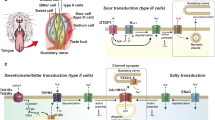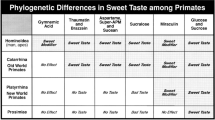Abstract.
Taste bud cells communicate with sensory afferent fibers and may also exchange information with adjacent cells. Indeed, communication between taste cells via conventional and/or novel synaptic interactions may occur prior to signal output to primary afferent fibers. This review discusses synaptic processing in taste buds and summarizes results showing that it is now possible to measure real-time release of synaptic transmitters during taste stimulation using cellular biosensors. There is strong evidence that serotonin and ATP play a role in cell-to-cell signaling and sensory output in the gustatory end organs.
Similar content being viewed by others
Author information
Authors and Affiliations
Corresponding author
Rights and permissions
About this article
Cite this article
Roper, S.D. Signaling in the Chemosensory Systems. Cell. Mol. Life Sci. 63, 1494–1500 (2006). https://doi.org/10.1007/s00018-006-6112-9
Published:
Issue Date:
DOI: https://doi.org/10.1007/s00018-006-6112-9




